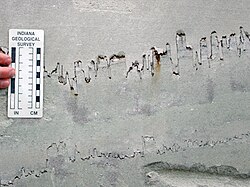Stylolite

Stylolites(Greek:stylos,pillar;lithos,stone) are serrated surfaces within arockmass at whichmineralmaterial has been removed bypressure dissolution,in a deformation process that decreases the total volume of rock. Minerals which are insoluble in water, such asclays,pyriteandoxides,as well as insolubleorganic matter,[1]remain within the stylolites and make them visible. Sometimes host rocks contain no insoluble minerals, in which case stylolites can be recognized by change intextureof the rock.[2]They occur most commonly in homogeneous rocks,[3]carbonates,cherts,sandstones,but they can be found in certainigneous rocksandice.Their size vary from microscopic contacts between two grains (microstylolites) to large structures up to 20 m in length and up to 10 m in amplitude in ice.[4]Stylolites usually form parallel tobedding,because ofoverburden pressure,but they can be oblique or even perpendicular to bedding, as a result oftectonicactivity.[5][6]
Classification of stylolites[edit]
In structural geology anddiagenesis,pressure solutionor pressure dissolution is a deformation mechanism that involves the dissolution of minerals at grain-to-grain contacts into an aqueous pore fluid in areas of relatively high stress and either deposition in regions of relatively low stress within the same rock or their complete removal from the rock within the fluid. It is an example ofdiffusivemass transfer.Stylolites are formed by this process.
Stylolites can be classified according to their geometry or their orientation and relationship to bedding.[4]
Geometric classification[edit]
Park and Schot (1968) recognized six different geometries in stylolites:[4]
- Simple or primitive wave-like
- Sutured type
- Up-peak type (rectangular type)
- Down-peak type (rectangular type)
- Sharp-peak type (tapered and pointed)
- Seismogram type
Relationship to bedding[edit]
- Horizontal stylolites
- This is the most commonly observed stylolite type. They occur parallel or nearly parallel to the bedding of rocks. This type is most frequently found in layeredsedimentary rocks,mostly incarbonate rocks,which have not been affected by intensivetectonicstructural activity ormetamorphism.
- Inclined stylolitesorslickolites
- This type occurs oblique to bedding. It appears in rocks which are both affected or unaffected by tectonic activity, and can also be found in metamorphic and layered igneous rocks.
- Horizontal-inclined(vertical) orcrosscutting stylolites
- This type is a combination of horizontal and inclined types of stylolites. Horizontal stylolites usually have a higher amplitude than inclined stylolites. Horizontal-inclined can be found in rocks affected by pressure parallel to the bedding plane followed by pressure perpendicular to bedding.
- Vertical stylolites
- This type of stylolite is related to the bedding at right angles. It may or may not be associated withtectonic activity.It is caused by pressure acting perpendicularly to the bedding.
- Interconnecting network stylolites
- This type is a network of stylolites, which are related to each other with relatively small angles. This type can be divided into two subtypes. Stylolites of subtype A are characterized by higher amplitudes. They are related to the bedding either horizontally, or at a small angle. Stylolites of subtype B usually appear in rocks which have been affected by tectonic and/or metamorphic activity. These stylolites have a lowamplitudewith undulations. Their relation to the bedding can vary from horizontal to vertical.
- Vertical-inclined(horizontal) orcrosscutting stylolites
- This type is a combination of horizontal or inclined and vertical stylolite types. In this case the inclined or horizontal stylolites were formed first and the vertical later. This type can be divided into two subtypes by directions of displacement of the inclined stylolites. In subtype A, the displacements could have happened during vertical stylolization, while in subtype B, the displacements could have happened before vertical stylolization.
Development[edit]
A stylolite isnotastructuralfracture,although they have been described as a form of 'anticrack', with the sides moving together rather than apart.[7]Proof exists in the form offossiliferous limestonewherefossilsare crosscut by a stylolite and only one half still exists; the other half has been dissolved away. Rye & Bradbury (1988)[8]investigated13/12C and18/16Ostable isotopesystematics in limestone on either side of a stylolite plane and found differences confirming different degrees of fluid-rock interaction.
In order for a stylolite to develop, asolutioninto which minerals candissolveneeds to be present, along with apore networkthrough which dissolved solids can migrate byadvectionordiffusionfrom the developing stylolite. Stylolite development can be improved withporosity,as it localizes stress on grains, increasing thestressthere. Therefore, it is suggested that bedding-parallel stylolites form in areas of highporosity,[9]and most of the transverse stylolites form along preexistingfractures.[2]
Significance[edit]
Stylolites are significant in several fields. Inpetrology,stylolites are important because they alterrock fabricsand dissolve solids that precipitate ascement.Instratigraphy,weatheringof stylolites generates apparent bedding in many stratigraphic sections and loss of material along stylolites can have a result similar toerosion,with significantstratigraphicthinning. Inhydrology,stylolites prevent fluid flow and, in other settings, serve for fluid flow. Also, stylolites are indicators ofcompressive stressin tectonic studies, and development of transverse stylolites contributes to crustal shortening parallel to the direction of their column.[2]
Gallery[edit]
-
A stylolite viewed in thin section in planepolarized lightin apackstone,Oehrlikalk formation of the Axen nappe, Wellenberg, Switzerland
-
Stylolite in a Slovakian limestone
See also[edit]
References[edit]
- ^Dunham J.B.; Larter S. (1981)."Association of Stylolitic Carbonates and Organic Matter: Implications for Temperature Control on Stylolite Formation".AAPG Bulletin.65.
- ^abcMiddleton, Gerard V., Encyclopedia of sediments andsedimentary rocks,2003, p. 90-92
- ^Golding, H. G.; Conolly, J. R. (1962). "Stylolites in volcanic rocks".Journal of Sedimentary Petrology.32(3): 534–538.doi:10.1306/74D70D12-2B21-11D7-8648000102C1865D.
- ^abcPark, Won C.; Schot, Erik H. (1968). "Stylolites: their nature and origin".Journal of Sedimentary Petrology.38(1): 175–191.doi:10.1306/74D71910-2B21-11D7-8648000102C1865D.
- ^Andrews, Lynn M.; Railsbak, L. Bruce (1997). "Controls on stylolite development: morphologic, lithologic, and temporal evidence form bedding-parallel and transverse stylolites from the U.S. Appalachians".Journal of Geology.105(1): 59–73.Bibcode:1997JG....105...59A.doi:10.1086/606147.JSTOR30079885.S2CID128917505.
- ^Petrology of thesedimentary rocks,F.H. Hatch, R.H. Rastall p. 382
- ^Fletcher, C.C. and Pollard, D.D. 1981 Anticrack model for pressure solution surfaces. Geology, 9, 419-24.
- ^Rye, DM, and Bradbury, HJ (1988): Fluid flow in the crust: an example from a Pyrenean thrust ramp. American Journal of Science (288): 197-235.
- ^Merino, E., Ortoleva, P., and Strickholm, P., 1983. Generation of evenly-spaced pressure-solution seams during (late) diagenesis: a kinetic theory. Contributions to Mineralogy and Petrology, 82: 360-370.


